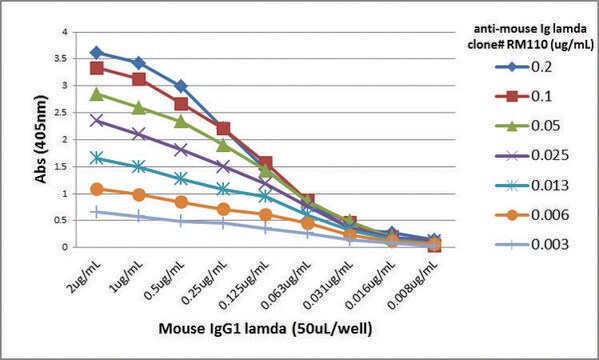SAB4200881
Anti-beta-Lactoglobulin antibody, Mouse monoclonal
clone BTS-10, purified from hybridoma cell culture
Synonym(s):
Beta-lactoglobulin
Sign Into View Organizational & Contract Pricing
All Photos(2)
About This Item
UNSPSC Code:
12352203
NACRES:
NA.41
Recommended Products
General description
ß-lactoglobulin also known as Bos d 5 allergen, can be detected in the mammary gland and highly expressive in the breasts. Bovine β-lactoglobulin (Beta-LG) is the major whey protein of cow′s milk1. This protein, which has 162 residues in its mature form, exists as a dimer in solution, where the dimer has a molecular weight of approximately 36 kDa 2. This protein is extensively a primary component that binds retinol 3. The ruminant animals have dimeric Beta-LG′s, which show very high sequence identity to bovine Beta-LG. Within a species, Beta-LG often exists in several genetic variants. The cow (Bos taurus), for example, has at least nine variants, labeled as A, B, C, D, E, H, I, J and W. The more common bovine Beta-LG variants (A, B, and C) respond differently to heat, a property of technological significance in the industrial processing of milk and for the characteristics of milk products 5. Bovine Beta-LG is stable at low pH, is resistant to proteolysis 6. Several variants have been identified, the main ones in the cow being labelled A and B 7 . Because of its abundance and ease of purification, it has been subjected to a wide range of biophysical studies.
Specificity
β-Lactoglobulin from bovine milk were used as the immunogen.
Application
The antibody is recommended to be used in various immunological techniques, including immunoblot and ELISA. Monoclonal Anti-?-Lactoglobulin is immunospecific to β--Lactoglobulin as determined by an immunoblot assay. Detection of the β-Lactoglobulin band by immunoblotting is specifically inhibited by the immunogen.
Biochem/physiol Actions
Beta-LG has a calyx fold, typical of the lipocalin protein superfamily, and shares with other lipocalins the ability to bind a variety of small hydrophobic molecules in vitro 4. b-Lactoglobulins are widely distributed. While some Beta-LG′s are monomeric, for example, horse, pig, and cat, most Beta-LG′s occur as dimers, especially, in the order of hoofed mammals.b-lactoglobulin is of direct interest to the food industry since its properties can variously be advantageous or disadvantageous in dairy products and processing. b -lactoglobulin is considered as a major milk allergen.
Physical form
Supplied as a solution in 0.01 M phosphate buffered saline pH 7.4, containing 15 mM sodium azide as a preservative.
Storage and Stability
For continuous use, store at 2-8°C for up to one month. For extended storage, freeze in working aliquots. Repeated freezing and thawing is not recommended. If slight turbidity occurs upon prolonged storage, clarify the solution by centrifugation before use. Working dilution samples should be discarded if not used within 12 hours. Protect from prolonged exposure to light.
Disclaimer
This product is for R&D use only, not for drug, household, or other uses. Please consult the Material Safety Data Sheet for information regarding hazards and safe handling practices.
Storage Class Code
12 - Non Combustible Liquids
WGK
WGK 1
Flash Point(F)
Not applicable
Flash Point(C)
Not applicable
Certificates of Analysis (COA)
Search for Certificates of Analysis (COA) by entering the products Lot/Batch Number. Lot and Batch Numbers can be found on a product’s label following the words ‘Lot’ or ‘Batch’.
Already Own This Product?
Find documentation for the products that you have recently purchased in the Document Library.
Articles
Antibody fragmentation with our pepsin digestion protocol for IgG antibody fragmentation and preparation of F(ab’).
Our team of scientists has experience in all areas of research including Life Science, Material Science, Chemical Synthesis, Chromatography, Analytical and many others.
Contact Technical Service








